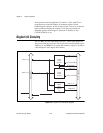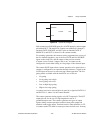
Chapter 3 Theory of Operation
©
National Instruments Corporation 3-27 AT-MIO-16X User Manual
Figure 3-18. Counter Block Diagram
Each counter has a SOURCE input pin, a GATE input pin, and an output
pin labeled OUT. The Am9513A counters are numbered 1 through 5,
and their GATE, SOURCE, and OUT pins are labeled GATE N,
SOURCE N, and OUT N, where N is the counter number.
For counting operations, the counters can be programmed to use any of
the five internal timebases, any of the five GATE and five SOURCE
inputs to the Am9513A, and the output of the previous counter
(Counter 4 uses Counter 3 output, and so on). A counter can be
configured to count either falling or rising edges of the selected input.
The counter GATE input allows counter operation to be gated. Once a
counter is configured for an operation through software, a signal at the
GATE input can be used to start and stop counter operation. The five
gating modes available with the Am9513A are as follows:
• No gating
• Level gating active high
• Level gating active low
• Low-to-high edge gating
• High-to-low edge gating
A counter can also be active high level gated by a signal at GATE N+1
and GATE N-1, where N is the counter number.
The counter generates timing signals at its OUT output pin. The OUT
output pin can also be set to a high-impedance state or a
grounded-output state. The counters generate two types of output
signals during counter operation: terminal count pulse output and
terminal count toggle output. Terminal count is often referred to as TC.
A counter reaches TC when it counts up or down and rolls over. In many
SOURCE
GATE
OUT
Counter


















